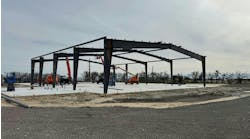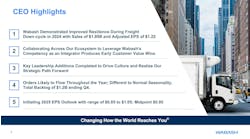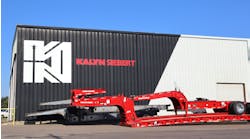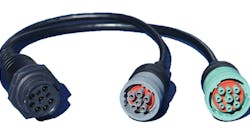It’s simple enough to explain what SAE J1939 is.
It’s an internationally recognized serial communication recommended practice for truck, bus, off-road, construction, and marine vehicle applications that defines a control and information network that supports vehicle control and safety systems on heavy-duty tractors, trucks, converter dollies, and trailers.
Its main purpose is to share information between vehicle computers—and that’s done by conveying it in messages containing parameters or signals. Each message or “parameter group” is identified by a unique PGN that provides the means for distributed control throughout the vehicle.
J1939’s open interconnect system allows devices to communicate with each other over a standard electronic network architecture, with the network being an implementation of a controller area network or CAN bus, which permits any device to transmit a message when the bus is idle. The J1939 protocol is based on CAN, which is why J1939 and CAN are usually mentioned together.
When everything is working properly, the system is an engineering marvel to behold. But if issues arise with the multiplexed communication technology, datalink cables, terminations, or vehicle databus, many types of failures can occur.
The American Trucking Associations’ (ATA) Technology & Maintenance Council held a session, “Diagnosing J1939 and OBD Communication Errors,” featuring Keith Littleton, program coordinator of training & diagnostics at WheelTime Network and president of KD Technical Innovations; George Arrants, director of training and recruiting at WheelTime Network; and technician Darrell Duggan.
Littleton’s big-picture message: Most of the tools and equipment being used in the truck industry are too slow to diagnose some the issues they are facing with the new vehicles.
“It is easier to see a failed signal as a picture on an oscilloscope instead of a bunch of numbers jumping around on a meter,” he said. “Many of the tests being performed in service information are static resistance measurements and open circuit testing, which are very unreliable. Dynamic testing is very reliable and allows the technicians to look at signals during normal operation.
“The normal testing that is being performed does not have procedures in place for dynamic testing. The procedures do a lot of disconnecting and replacing with a known good part. This can become very expensive and many times not a conclusive diagnosis.
“The procedures being used in the industry still have mistakes and allow technicians to misdiagnose. The new procedures I am introducing are ways for technicians to test components and circuitry while they are operating and using a tool that is fast enough to capture failures that no scan tool or digital multimeter could never do. Oscilloscopes have the ability to look at communication failures and component/circuitry concerns that allows technicians to diagnose much faster and some things they would have to guess with replacing.
“The scope also can decode communication for further diagnosis by looking at message length, BUS load calculations, and even electrical noise that can very difficult to diagnose. The training and service information available to technicians of today are not providing them with the necessary skillsets to diagnose the vehicles of tomorrow.”
Littleton said it’s difficult to diagnose a problem with only half of the picture.
“Every technician in this room has gotten to a point where he has done everything the service info says, and it still didn’t fix the truck,” he said. “Everybody can diagnose, and you have your own way of doing it. But if you have the whole picture, you can diagnose quicker.
“Having a picture of something can definitely allow you to get the rest of the picture. You have data on your scan tools. You have data on your visual alternator. Whatever you’re doing, a lot of times looking at a picture makes it a lot better.
“When you’re measuring voltage, you’re looking at an average of something. To me, the volt meter is half the information, but looking at the communication is the other half.
“With service information, you’re going to see the information available to us. It’s good stuff. But everyone who has worked on something has said, ‘It got me to a point and it still didn’t fix it.’ So we have scan tools, we have special equipment. How many of you have actually used a scope to diagnose something?
“Do we provide the proper training for our technicians? I can answer that. I’ve been training technicians for quite a while, and we have lot of high-quality technicians, but we have a lot of guys who aren’t trained. Do we have the right special equipment?”
Arrants said we’ve all seen the squiggly lines on a heart-rate monitor. They help a doctor diagnose any problems. The J1939 system works in the same fashion, but much faster.
“We measure things in millionths and billionths of a second as information travels through our trucks,” he said.
Littleton asked the attendees, “How fast can you count to 1000?” He said the average is five minutes. It would take 14 days to count to one million, doing it 24 hours a day, and 31 years to count to one billion.
“I’m telling you this because this is important for you to see how big this number is,” he said. “Intermittent problems always exist. They happen so quickly sometimes we can’t see them on a digital multimeter. The computer on the truck can’t see them.”
He said a digital multimeter (DMM) can count between 1/100th of a second and 1/1000th of a second, with a newer one doing it in 1/4000th. He said most engine control units (ECUs) count up to a millionth of a second and an oscilloscope can count up to a billionth of a second.
He said with an ECU, the challenge is how much of the computer can be designated to see a sensor/signal fault at that speed.
“The enabling criteria for setting a failure code is programmed so that signal must drop or raise for a specific length of time to fail, and the computer will only sample what it is told,” he said. “An oscilloscope actually peels back the onion and says, ‘I can look at it so fast that intermittent problems go away. I can report it for you. I can show you lot of different data.’ And it’s raw data. Raw data is a real number. It’s a true number. That’s a number I can live with. But scan data is inferred data. Its data that’s been interpreted.
“How could a scope help with intermittent wiring concerns? Most intermittent concerns happen so fast a DMM and ECU cannot see them. But a scope can.
“I have many diagnostic procedures I’ve done over the years. When I first started doing it, I wasn’t using an oscilloscope. There were ways I got around it. But once I started embracing it, it started giving me a better picture of how to diagnose very quickly.”









